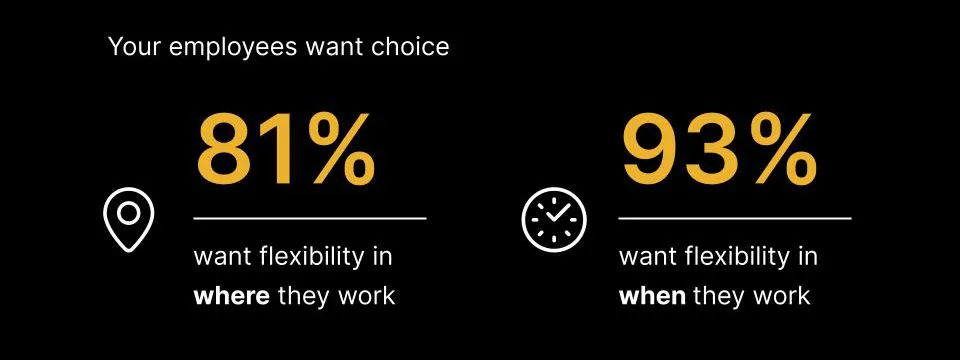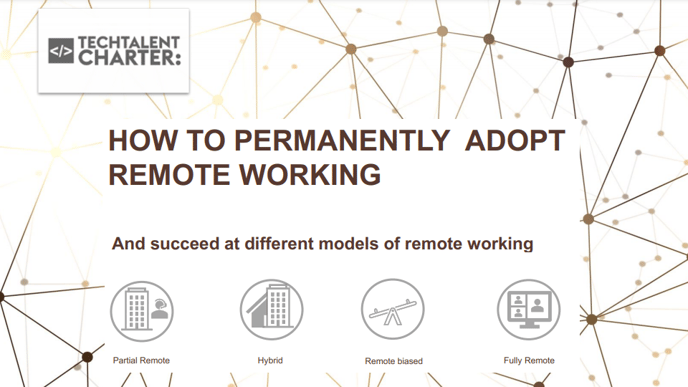'1 in 10 women want to work mostly on-site, and many women point to remote and hybrid work options as one of their top reasons for joining or staying with an organisation', Women in the Workplace: Key Findings 2022, LeanIn.
Employer recommendations
According to a Future Forum Pulse Report (published February 2023), drawing on data from a survey of 10,243 workers across the U.S., Australia, France, Germany, Japan, and the U.K., flexibility ranks second only to compensation in determining job satisfaction.
➖Working remotely helps some demographic groups (including underrepresented groups) more than others:
- The Future Forum Pulse Report (published February 2023) reported that 'Consistent with our findings quarter over quarter, the desire for flexibility remains strongest among underrepresented groups, including women, working mothers, and people of color'.
- LeanIn's 2022 Women in the Workplace: Key Findings report reported that 'When women work remotely, they experience fewer microaggressions and higher levels of psychological safety. The decrease in microaggressions is especially pronounced for women of color, LGBTQ+ women, and women with disabilities—groups who typically face more demeaning and othering behavior'.
- 'Along with a transition to skills-first hiring, flexibility will be key to improving women representation, in particular access to remote positions. Applications by women to remote roles have been increasing year over year on average in EMEA and LATAM. In 2022, women applied to 11% more remote roles than men in Germany, 4% in Ireland, 9% in the United Arab Emirates, and 19% in Mexico. As companies row back on flexibility, and as the share of remote roles continues to drop, for the ninth consecutive month in the EMEA region as a whole, competition is becoming fierce for remote roles' 'The number of women hired into leadership is increasing, but by less than 1% a year', LinkedIn.
➖Communicate about the importance of flexibility using internal data about what your employees want or use external data.
➖Monitor project allocation.
Check that exciting or stretch projects are not just given to those employees going into the office because they are visible. Some dominant groups may be working from the office more often than other groups for example, men / women, non disabled employees / disabled employees, so if project or work allocation is not fairly distributed to virtual and office based employees this could potentially impact career advancement.
➖Encourage workers to disconnect meaningfully when working remotely.
➖Conduct regular pulse surveys to find out what is working, what isn’t working, and how employees would like further support.
➖Consider the type of work teams are engaging in and determine key points in time or reasons to gather in person.
Microsoft internal data has identified three specific moments when in-person time is most beneficial:
-
Strengthening team cohesion
-
Onboarding to a new role, team, or company
-
Kicking off a project.
Tips for people managers
- Build space for diverse perspectives and encourage participation from all participants. To ensure team members have an equal opportunity to contribute in virtual meetings, leaders must prevent remote attendees from defaulting to observer mode.
- Be direct, clear and concise: sometimes when we send an online message, our thoughts can get lost in translation. Make sure you’ve been understood as intended.
- Send out an agenda for meetings ahead of time, with clearly defined roles and content topics. Have a rotating schedule of call facilitators.
- Start the meeting by asking everyone to answer the same question to get their voices into the discussion.
- Ensure people get the credit they deserve and clarify who raised an idea; return the conversation to someone who has been talked over or interrupted; pay attention to who is not speaking and actively bring them into the dialogue.
- Ask about people’s needs (instead of assuming), acknowledge them, and tailor actions accordingly. Ask team members to share potential distractions or challenges they are facing and what they need to be fully present.
- The mindset of managers must be to trust that people can be fully effective when they are not face to face. One common challenge related to remote working stems from the fear that the people manager will lose control. One mechanism for regaining the sense of control is ensuring that all employees have clear outcomes against which they will be held accountable. Like other forms of unconscious bias, help managers explore and dissect their own reservations around remote and hybrid work and help them focus on outcomes.
- Make time for structured remote team building and networking.
- Managers and colleagues should maintain virtual informal checkins with remote working employees so that they do not feel excluded. Those that return are more easily able to have informal chats with colleagues and leaders, make connections, bonds, and build their network.
- Schedule regular one-on-one check-ins to discuss how individual team members are doing; assess their goals, interests, and explore their professional development intentions. Leaders should keep a running list of who they spoke with, and when, to ensure interaction with the whole team.
During a TTC hackathon, one team of subject matter experts was tasked with hacking the topic, 'How to permanently adopt remote working' - this team won our hackathon.
During a TTC Hackathon, subject matter experts co-designed a new product on 'Systems and cultures that support inclusive hybrid working'
Further information
- Guide: Making remote work, work, from the Tech CEO Communications Toolkit by Tyto
- Guide: Hybrid Working Practical Guidance, CIPD
- Guide: Sustaining and strengthening inclusion in our new remote environment, McKinsey
- Research Report: Beyond the Hybrid Hype: Insights based on the hybrid working practice and plans of 14 UK companies, Timewise
- Article: Who Wants To Return To The Office?, ThirtyFiveEight
- Article: How to build a culture of trust in your company, Fast Company
- Article: The Neuroscience of Trust: Why it Matters for Teams and Organizations, Paul Zak, Ph.D
- Guide: Flexible working guidance for managers and leaders, CMI
- Guide: 7 ways to support neurodivergent employees working from home, Texthelp
- Report: Women in the Workplace: 2022, LeanIn
- Report: Future Forum Pulse Report, Future Forum
- Article: The number of women hired into leadership is increasing, but by less than 1% a year, LinkedIn


